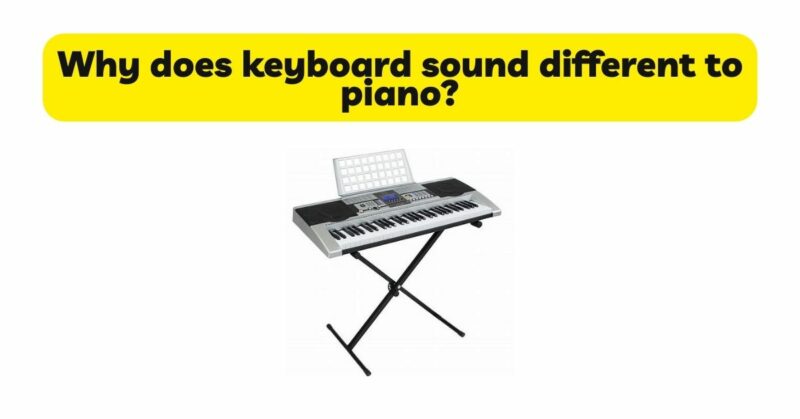The sound produced by a keyboard and a piano may vary significantly, leading to distinctive sonic characteristics that discerning musicians can readily identify. While keyboards and pianos serve as versatile musical instruments, they differ in design, mechanisms, and sound generation techniques. In this article, we explore the factors that contribute to the differences in sound between keyboards and pianos, including the sound generation process, tonal complexity, resonance, dynamic range, and touch sensitivity. By understanding these factors, we can shed light on the reasons behind the dissimilarities in sound, enabling musicians to appreciate and leverage the unique qualities of each instrument.
- Sound Generation Process: The sound generation process is one of the primary factors that differentiate the sound of keyboards from that of pianos. Keyboards typically employ digital sound synthesis, where electronic circuits or software algorithms generate sounds based on samples or mathematical models. On the other hand, pianos produce sound acoustically by mechanically striking strings with hammers, resulting in a naturally resonant and complex sound. The inherent differences in the sound generation process contribute to variations in timbre, sustain, and harmonic content between keyboards and pianos.
- Tonal Complexity: The tonal complexity of pianos exceeds that of keyboards due to the intricate physical interactions between the strings, soundboard, and other components. Pianos possess a rich and dynamic tonal palette, with the ability to produce a wide range of overtones and harmonics. These complex tonal characteristics contribute to the depth, warmth, and fullness of the piano sound. Keyboards, while capable of producing diverse sounds, may lack the same level of tonal complexity, resulting in a comparatively simpler and more uniform sonic profile.
- Resonance: The resonance of an acoustic piano is a distinctive feature that sets it apart from keyboards. When the strings of a piano are struck, the vibrations transfer to the soundboard and other parts of the instrument, creating sympathetic resonances that enrich the overall sound. This resonance enhances the sustain, decay, and interaction between notes, adding depth and complexity to the piano sound. Keyboards, on the other hand, often rely on artificial means to simulate resonance, which may not capture the same level of natural and organic resonance found in pianos.
- Dynamic Range: Pianos offer a wide dynamic range, capable of producing both delicate pianissimo passages and thunderous fortissimo sounds. This dynamic expressiveness is partly due to the physical mechanisms involved in piano playing. Musicians can control the intensity and velocity of their key strikes, resulting in nuanced variations in volume and tone. Keyboards, while offering varying degrees of touch sensitivity, may not always replicate the same level of dynamic range as pianos. The inherent limitations of digital sound synthesis and the absence of mechanical action can impact the ability to produce the same level of dynamic expression.
- Touch Sensitivity: The touch sensitivity of a piano is a critical factor in shaping the sound and expression. Pianos respond to the player’s touch, allowing for variations in volume, tone, and articulation based on the force applied to the keys. The weighted keys and mechanical action of pianos provide a tactile feedback that facilitates nuanced playing and control. Keyboards often aim to replicate touch sensitivity through weighted or semi-weighted keys and velocity sensitivity. While these features can emulate the basic touch response, the tactile feedback and subtleties of playing a piano may not be fully replicated on a keyboard.
- Sound Reproduction: Keyboards rely on amplification and sound reinforcement systems, such as built-in speakers or external amplifiers, to reproduce the sound. These systems have limitations in faithfully reproducing the nuances and complexities of the piano sound. Acoustic pianos, on the other hand, rely on the resonant properties of the instrument itself and do not require amplification to project sound. The physical properties of pianos contribute to a natural and immersive sound projection that may be challenging to replicate in a keyboard’s amplified sound.
Conclusion: The differences in sound between keyboards and pianos stem from factors such as the sound generation process, tonal complexity, resonance, dynamic range, and touch sensitivity. While keyboards offer versatility, portability, and a wide array of sounds, they may not replicate the depth, complexity, and organic resonance of an acoustic piano. Understanding and appreciating these differences can help musicians make informed decisions when selecting an instrument for their musical endeavors. By recognizing the unique qualities of each instrument, musicians can leverage the strengths of both keyboards and pianos to explore a wide range of musical possibilities and create captivating performances.


